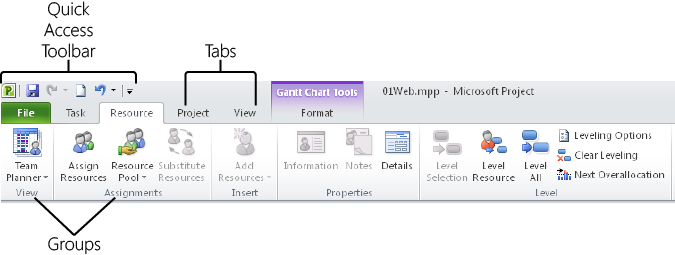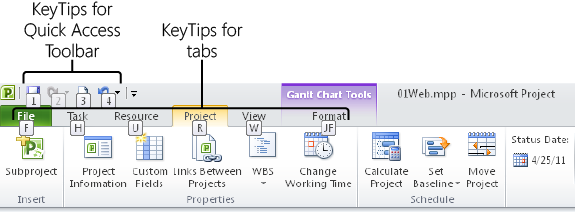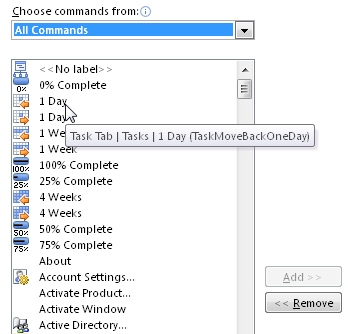 Using the Project Ribbon
by Teresa S. Stover, Bonnie Biafore, and Andreea Marinescu
Microsoft® Project 2010 Inside Out
Using the Project Ribbon
by Teresa S. Stover, Bonnie Biafore, and Andreea Marinescu
Microsoft® Project 2010 Inside Out
- Microsoft® Project 2010 Inside Out
- SPECIAL OFFER: Upgrade this ebook with O’Reilly
- A Note Regarding Supplemental Files
- Introduction
- I. Project Fundamentals
- 1. Introducing Microsoft Project 2010
- 2. Understanding Projects and Project Management
- II. Developing the Project Plan
- 3. Starting a New Project
- Getting from Idea to Proposal to Project
- Focusing the Project Vision
- Creating a New Project Plan
- Entering Tasks
- Sequencing and Organizing Tasks
- Organizing Tasks into an Outline
- Setting Up Your Work Breakdown Structure
- Adding Supplementary Information to Tasks
- 4. Viewing Project Information
- Understanding Project Information Categories
- Accessing Your Project Information
- Switching Between Views
- Using Views
- Scheduling with Gantt Charts
- Highlighting Tasks with the Timeline
- Flowcharting with Network Diagrams
- Visualizing the Project with the Calendar
- Reviewing Assignments with the Team Planner
- Charting Team Availability with the Resource Graph
- Tabling with Sheet Views
- Timesheeting with Usage Views
- Seeing Details with Forms
- Cross-Referencing with Combination Views
- Using Tables
- Using Fields
- Arranging Your Project 2010 Window
- Navigating to a Specific Location in a View
- Rearranging Your Project Information
- 5. Scheduling Tasks Manually or Automatically
- 6. Building Your Schedule
- 7. Setting Up Resources in the Project
- Understanding the Impact of Resources in the Plan
- Adding Resources to the Project
- Removing a Resource from the Project
- Identifying Tentative, Generic, or Budget Resources
- Setting When Resources Are Available for Work
- Adding Detailed Resource Information
- 8. Assigning Resources to Tasks
- Assigning Work Resources to Tasks
- Assigning Material Resources to Tasks
- Assigning Cost Resources to Tasks
- Reviewing Assignment Information
- Changing Resource Assignments
- Contouring Resource Assignments
- 9. Planning Resource and Task Costs
- 10. Checking and Adjusting the Project Plan
- Working with the Critical Path and Critical Tasks
- Controlling Schedule Changes with Task Types
- Bringing in the Project Finish Date
- Reducing Project Costs
- Balancing Resource Workloads
- Changing Project Scope
- Reviewing the Impact of Changes
- Obtaining Buyoff on the Project Plan
- 3. Starting a New Project
- III. Tracking Progress
- 11. Setting a Baseline and Updating Progress
- Saving Original Plan Information Using a Baseline
- Updating Task Progress
- Updating Actual Costs
- 12. Responding to Changes in Your Project
- 11. Setting a Baseline and Updating Progress
- IV. Reporting and Analyzing Project Information
- 13. Reporting Project Information
- Establishing Your Communications Plan
- Using Views to Report Project Information
- Generating Text and Visual Reports
- Generating the Right Reports
- Summarizing with Overview Reports
- Focusing on Tasks with Schedule Progress Reports
- Using the Unstarted Tasks Report
- Using the Tasks Starting Soon Report
- Using the Tasks In Progress Report
- Using the Completed Tasks Report
- Using the Should Have Started Tasks Report
- Using the Slipping Tasks Report
- Using the Baseline Report in Visio
- Using the Baseline Work Report in Excel
- Using the Task Status Report in Visio
- Using the Budget Work Report in Excel
- Analyzing Budget Status with Cost Reports
- Using the Cash Flow Report
- Using the Cash Flow Report in Excel
- Using the Cash Flow Report in Visio
- Using the Baseline Cost Report in Excel
- Using the Budget Report
- Using the Budget Cost Report in Excel
- Using the Resource Cost Summary Report in Excel
- Using the Overbudget Tasks Report
- Using the Overbudget Resources Report
- Using the Earned Value Report
- Using the Earned Value Over Time Report in Excel
- Evaluating Resource Allocation with Assignment Reports
- Using the Who Does What Report
- Using the Who Does What When Report
- Using the To-Do List
- Using the Overallocated Resources Report
- Using the Resource Availability Report in Visio
- Using the Resource Work Availability Report in Excel
- Using the Task Usage Report
- Using the Resource Usage Report
- Using the Resource Work Summary Report in Excel
- Using the Resource Remaining Work Report in Excel
- Using the Resource Status Report in Visio
- Revising a Built-In Report
- Building a Custom Report
- Saving Project Data Fields
- Sharing Project Reports Electronically
- 14. Analyzing Progress Using Earned Value
- 13. Reporting Project Information
- V. Managing Multiple Projects
- 15. Managing Master Projects and Resource Pools
- Structuring Master Projects with Subprojects
- Consolidating Project Information
- Opening Multiple Project Files as a Set
- Sharing Resources by Using a Resource Pool
- 16. Exchanging Information Between Project Plans
- 15. Managing Master Projects and Resource Pools
- VI. Integrating Project 2010 with Other Programs
- 17. Exchanging Information with Other Applications
- 18. Integrating Project 2010 with Excel
- 19. Integrating Project 2010 with Visio
- 20. Integrating Project 2010 with Outlook
- 21. Collaborating as a Team by Using SharePoint
- Creating a Project Tasks List on a SharePoint Site
- Exchanging Project Information with SharePoint
- Synchronizing Changes Between Project and SharePoint
- Opening and Viewing Connected Project Information
- Collaborating with Team Members on Task Updates
- Assigning Tasks to Team Members
- Updating Task Progress
- Updating Task Progress in SharePoint
- Updating Task Progress in Project
- VII. Managing Projects Across Your Enterprise
- 22. Understanding Enterprise Project Management
- 23. Administering Your Enterprise Project Management Solution
- Signing In and Out
- Configuring Project Server Security
- Administering the Enterprise Resource Pool
- Establishing the Enterprise Portfolio
- Setting Up Project Workflows
- Standardizing Enterprise Project Elements
- Setting Up Team Member Work Pages
- Managing Pages, Views, and Reports
- 24. Managing Enterprise Projects and Resources
- Connecting to Your Project Server
- Working with Enterprise Projects
- Following a Project Workflow
- Building Your Enterprise Project Team
- Finding Resources to Meet Your Needs
- Building Your Project Team in Project Professional
- Building Your Project Team in Project Web App
- Identifying Resource Attributes by Using Custom Enterprise Fields
- Using Generic Resources as Placeholders
- Adding a Team Assignment Pool to Your Project Resource List
- Finding Enterprise Resources That Meet Specific Criteria
- Review Resource Assignments and Availability
- Replacing an Existing Project Resource with an Enterprise Resource
- Matching an Existing Project Resource
- Matching and Replacing Generic Resources
- Proposing Tentative Resources
- Assigning Tasks to Enterprise Resources
- Finding Resources to Meet Your Needs
- Collaborating with Your Project Team
- 25. Participating on a Team Using Project Web App
- Getting Started with Project Web App
- Working with Your Assignments
- Submitting Text-Based Status Reports
- Logging Time by Using Timesheets
- Working with Issues and Risks
- Setting Up E-Mail Reminders and Outlook Tasks
- Managing Resources in Project Web App
- 26. Making Executive Decisions Using Project Web App
- 27. Managing and Analyzing Project Portfolios
- VIII. Customizing and Managing Project Files
- 28. Customizing Your View of Project Information
- Customizing Views
- Changing the Content of a View
- Creating a New View
- Saving a View
- Changing Text Formatting in Views
- Formatting a Gantt Chart View
- Modifying the Timescale
- Modifying a Network Diagram
- Modifying the Timeline
- Modifying the Team Planner
- Modifying the Resource Graph
- Modifying the Calendar
- Modifying a Sheet View
- Modifying a Usage View
- Customizing Tables
- Customizing Fields
- Working with Outline Codes
- Customizing Groups
- Customizing Filters
- Sharing Customized Elements Among Projects
- Customizing Views
- 29. Customizing the Project 2010 Interface
- 30. Automating Your Work with Macros
- 31. Standardizing Projects by Using Templates
- 32. Managing Project Files
- Saving Project Files
- Opening Project Files
- Saving and Opening with Different File Formats
- Comparing Project Plans Side by Side
- Safeguarding Your Project Files
- 28. Customizing Your View of Project Information
- IX. Appendixes
- D. Index to Troubleshooting Topics
- E. About the Authors
- Index
- About the Authors
- SPECIAL OFFER: Upgrade this ebook with O’Reilly
With Project 2010, the Microsoft Office ribbon and Quick Access Toolbar are introduced to the Project user interface. This is a substantial change to the way you access Project 2010 features and tools. If you’ve been working with any other Microsoft Office applications that use the ribbon and Quick Access Toolbar, you have a head start in understanding how commands are organized. Instead of arranging commands in menus and toolbars, the ribbon presents commands graphically and logically organized in tabs and groups, as shown in Figure 1-26. Often the tabs change depending on which view you’re showing. The Quick Access Toolbar shows a handful of the most commonly used commands.
Throughout the procedures in this book, directions to find a command are given in the following format: “On the Task tab, in the Schedule group, click Link Tasks.” Sometimes the directions are abbreviated to something like “Click Task, Schedule, Link Tasks.”
Note
The look of the ribbon adjusts according to the resolution of your screen and the size of your Project 2010 window. Narrower screens show all groups, but the buttons might be smaller or moved to a drop-down menu instead of appearing directly on the ribbon.
You can hide the ribbon so that only the tab labels are showing, without a tab’s groups or buttons. When you click a tab in the minimized ribbon, the full ribbon appears. After you click a button, the ribbon is minimized again. This is a great way to give yourself more working space in the project plan, either temporarily or after you’re familiar with where commands are on the ribbon.
In the upper-right corner of the Project 2010 window, click the Minimize The Ribbon icon.
To show the full ribbon again, in the upper-right corner of the Project 2010 window, click the Expand The Ribbon icon.
Even though menus are gone, you can still quickly apply commands with keyboard shortcuts, called access keys. Every command on the ribbon can be executed by using access keys, which get you to a command in two to four keystrokes. To use access keys to execute a command on the ribbon, follow these steps:
Press and release the Alt key.
KeyTips are displayed above each feature in the current view, as shown in Figure 1-27.
Press the letter shown in the KeyTip that corresponds with the tab you want to use. Do this even if the tab you want is already showing.
The tab you select becomes active, and the KeyTips for the features on that tab appear, as shown in Figure 1-28.
Press the letter shown in the KeyTip that corresponds with the command you want.
Depending on the command, a dialog box might open, a drop-down menu might appear, or the command might be executed.
To use access keys to execute a command on the Quick Access Toolbar, follow these steps:
Press and release the Alt key.
Press the KeyTip number that corresponds to the command you want.
The command is executed.
Suppose that you used a certain command in earlier versions of Project, and now you can’t find it on the Project 2010 ribbon. Locate it by following these steps:
On the File tab, click Options.
The Project Options dialog box appears.
In the left pane, click Customize Ribbon or Quick Access Toolbar.
A list of commands appears in the Project Options dialog box.
In the Choose Commands From box, click All Commands.
All commands throughout Project 2010 are listed.
Scroll through the list to find the command you want.
To find where the command is located on the ribbon, rest the mouse pointer over the command name.
The location of the command appears, including the name of the tab, group, and command.
The commands are listed in alphabetical order. You might need to look in a couple different places if you’re not sure of the exact command name.
You might also try clicking Commands Not In The Ribbon in the Choose Commands From box. If you need to use a command that’s not on the ribbon, you can add it to the Quick Access Toolbar or to a custom group.
Note
For more help on finding commands, use the interactive ribbon guide in Project 2010 online Help at www.microsoft.com/project/en/us/ribbon_guide.aspx. Click a graphic of the toolbars and menus from Microsoft Project 2007 to learn where those commands are located on the Project 2010 ribbon.
Customize the Ribbon and Quick Access Toolbar
You can customize the ribbon in a variety of ways. You can add a custom group with the commands you want to an existing tab. You can even create your own custom tab with custom groups arranged on them. For details, see Customizing the Project 2010 Ribbon.
You can also customize the Quick Access Toolbar with commands you use most frequently. For details, see Customizing the Quick Access Toolbar.
-
No Comment



